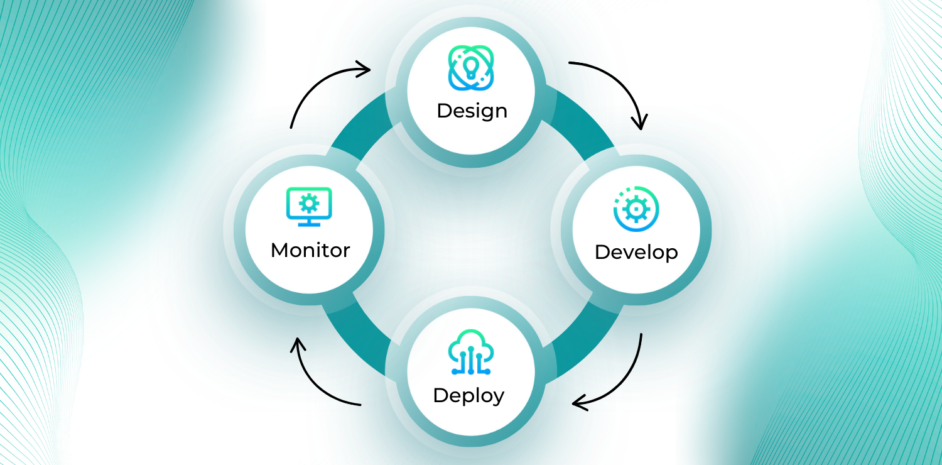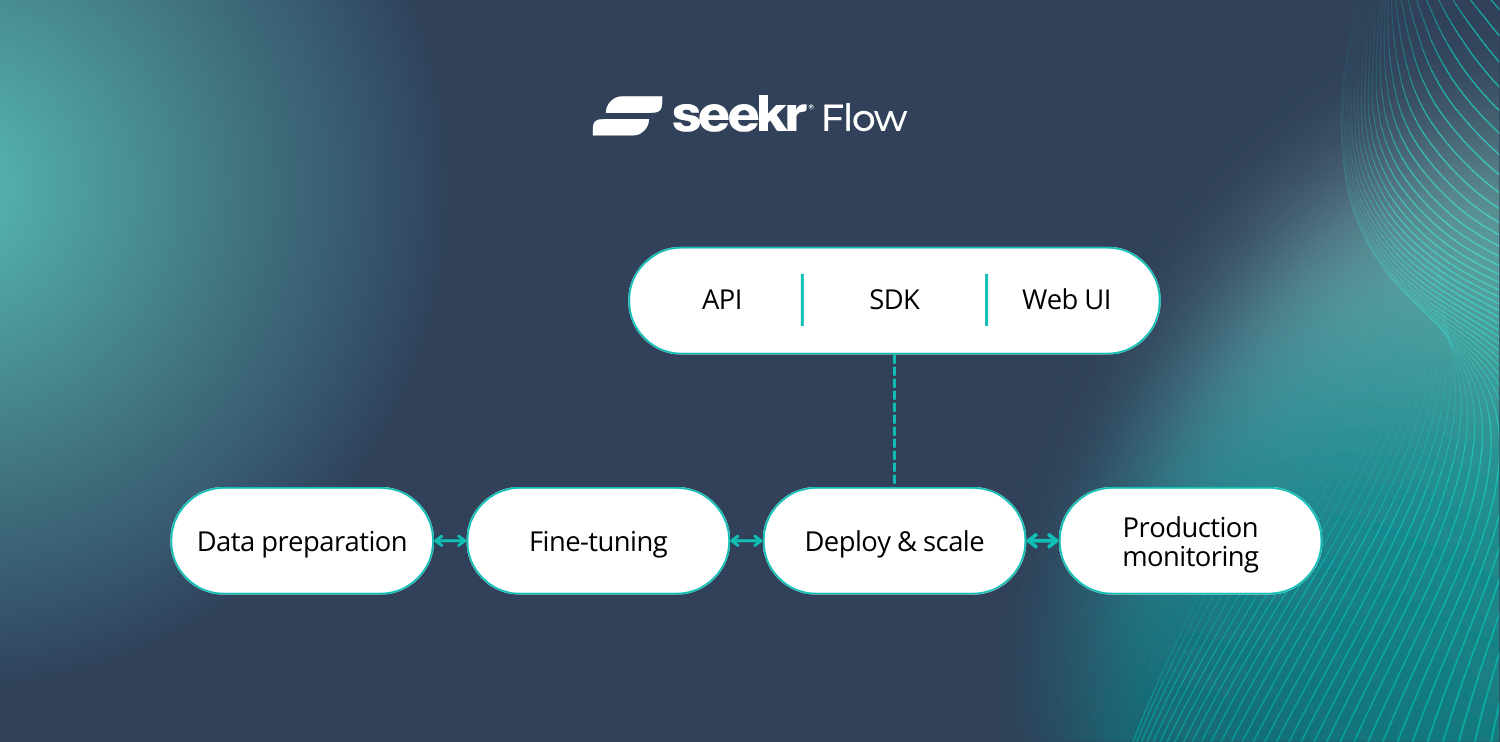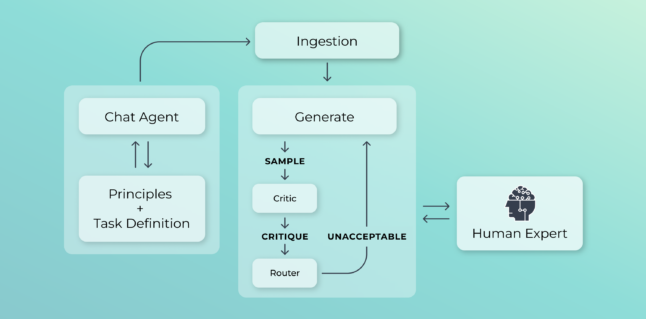Key takeaways:
- The AI lifecycle is an ongoing process of discovery, development, deployment, monitoring, and retraining to meet the requirements of the enterprise.
- The path to AI ROI is complex. Reports show that only 15% of organizations have the necessary infrastructure to support AI systems, and 85% of AI/machine learning projects fail to produce a return for the business.
- This is because teams face several logistical challenges including data management, tool integrations, talent resources, and overhead costs, creating a process full of friction and hurdles.
- Enterprises need to prioritize strategy and choose the right tools to enable responsible data management and optimized model performance.
- SeekrFlow™ simplifies the entire AI lifecycle, giving enterprises the tools they need to build and run trusted AI in one place.
- Contact our team to learn how SeekrFlow can help overcome the biggest challenges in lifecycle management and drive ROI.
Demystifying the AI lifecycle
The AI lifecycle is a complex, multi-step process. Overcoming its many challenges starts with breaking down and understanding the four key phases: design, develop, deploy, and monitor.
Design
The Design phase lays the foundation of a successful AI strategy: defining the problem, setting clear objectives, and selecting the appropriate AI methodologies.
The first and most crucial step is clearly defining the use case. AI excels at probabilistic reasoning, pattern recognition, content generation, and tasks with an element of creativity. And with recent breakthroughs like Retrieval Augmented Generation (RAG), the boundaries of what problems AI can solve are being pushed at an exponential rate.
Develop
In this phase, the selected AI model is brought to life through pre-training, fine-tuning, and prompt engineering to adapt it to the specific business context. Both pre-training and fine-tuning require extensive data preparation, which makes this one of the most laborious and time-consuming stages in the AI lifecycle.
- Pre-training: Base model performance is often insufficient for use cases requiring domain-specific expertise, so development teams conduct further pre-training through unsupervised learning with large-scale unlabeled data.
- Fine-tuning: Unlike continued pre-training which relies on a large unlabeled dataset, fine-tuning refines the model using a domain-specific dataset that has been curated and annotated to ensure accuracy and desired model responses.
- Prompt engineering: After fine-tuning, prompt engineering further tailors the model’s behavior to meet specific user expectations, like instructing the model to provide advice in a particular tone, provide concise summaries, or produce more creative responses.
- Testing and validation: Validation is an iterative process that mitigates risks and ensures the model delivers consistent results in production. The previous steps in the Develop phase may need to be repeated multiple times before the model meets requirements for launch.
Deploy
Once validated, the model is deployed into the production environment. Teams integrate the model into the business’s operational workflows and ensure it seamlessly interacts with existing systems and data pipelines. Deployment is when the model begins delivering real value to the organization, but it’s by no means the end of the AI lifecycle—it marks the beginning of an ongoing process of monitoring and improvement.
Monitor
In production monitoring, development teams use various metrics and feedback mechanisms to understand model performance and react when they start underperforming. Based on the collected feedback, the model may undergo retraining with updated datasets to ensure the AI solution remains effective, accurate, and aligned with evolving business goals.
Where enterprises lose their way
Because of the complex nature of the AI lifecycle, teams can struggle to launch an AI solution and maintain its performance and accuracy. The entire lifecycle requires extensive tools and talent that can sink an enterprise’s budget before they ever make it to production.
Recent industry reports show only 15% of organizations have the necessary infrastructure to support the AI lifecycle. This hurdle, among others, contributes to the reality that 85% of AI/ML projects fail to produce a return.
Key obstacles to overcome
Data preparation and management
The process of data gathering, structuring, annotating, and mitigating errors and biases in training data is resource-intensive and time-consuming, but high-quality data is the most critical step to achieve model accuracy.
Tool integration
AI projects typically require multiple tools for different stages of the lifecycle—ranging from data annotation to deployment and monitoring. Integrating these tools, especially when sourced from different vendors, adds complexity, friction, and extraneous costs.
Skill requirements
The development and management of AI models require specialized skills, which are not always available within an organization. This skill gap often calls for external expertise or reliance on third-party platforms.
Cost
Research shows that organizations spend more than 80% of their total budget on AI infrastructure. The true lifecycle cost of AI adoption is substantial, with significant investments required for hardware, software, human resources, and ongoing operational costs.
Five steps to overcome cost and complexity in the AI lifecycle
Model lifecycle management is no small task. To launch a truly successful AI solution, enterprises need to get clear on their strategy, streamline operations, and choose the right tools to enable responsible data management and optimized model performance.
1. Simplify the MLOps toolset
Teams don’t need to piece together tools for each stage of the lifecycle. Using a seamless platform that facilitates data preparation, fine-tuning, deployment, and production monitoring can eliminate the friction of tool integrations and reduce manual errors and inefficiencies throughout the process.
2. Streamline data management
Prioritizing data quality helps avoid the downstream costs associated with troubleshooting model hallucinations and undesired outputs.
Automating data gathering, filtering, labeling, and annotation can save time and resources, and enable development teams to invest more time and energy into optimizing model performance. With SeekrFlow’s Principle Alignment feature, teams can use an autonomous workflow to generate high quality, custom training data in a fraction of the cost and time of traditional methods.
3. Embrace transparency and explainability
Enhancing data and model transparency helps teams understand decision-making processes, debug issues, and establish trust with end users. Explainability tools that offer insights into model behavior make it easier for development teams to identify and correct errors, biases, and areas of underperformance.
4. Prioritize iterative improvements
Develop a clear procedure to collect user feedback and iteratively retrain models to ensure ongoing accuracy. Tools with built-in deployment dashboards and monitoring systems can help teams detect performance drift faster and streamline retraining procedures.
5. Optimize price-performance
Increasing AI ROI starts with reducing overhead costs. Consolidating tools and adopting automation techniques helps businesses of all sizes reduce the overall costs of AI development.
Enterprises also need to consider the price-performance of their hardware and software selections. Through Seekr and Intel’s strategic collaboration, enterprises can access trusted compute at a superior price-performance with Intel Gaudi AI accelerators in the Intel Tiber Developer Cloud.
Mastering the AI lifecycle: the key to driving ROI
Managing the AI model development lifecycle is a complex, ongoing process with significant hurdles that can prevent businesses from realizing a return on AI.
By simplifying data preparation and management, integrating development tools into one platform, and enabling real-time production monitoring and iterative model improvement, SeekrFlow empowers organizations to accelerate their time to AI value.





